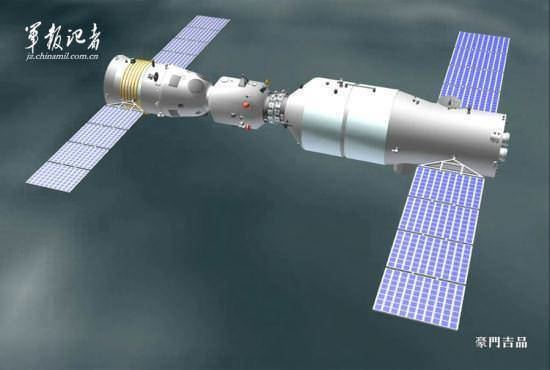COSPAR ID 2011-063A Mission duration 16 ⁄2 days Dates 31 Oct 2011 – 17 Nov 2011 Landing date 17 November 2011 | SATCAT no. 37859 Inclination 51.36872° Launch date 31 October 2011 | |
 | ||
Landing site Siziwang Banner, central Inner Mongolia | ||
China hopes shenzhou 8 will aid space lab project
Shenzhou 8 (Chinese: 神舟八号) was an unmanned flight of China's Shenzhou program, launched on October 31, 2011 UTC, or November 1 in China, by a Long March 2F rocket which lifted off from the Jiuquan Satellite Launch Center.
Contents
- China hopes shenzhou 8 will aid space lab project
- History
- Mission
- Final Shenzhou spacecraft design
- References
The Shenzhou 8 spacecraft was automatically docked with the Tiangong-1 space module (launched on 29 September 2011) on November 3 and again on November 14, 2011. This unmanned docking—China's first—was followed in 2012 with the manned Shenzhou 9 mission, which performed a manned docking (also China's first) with the Tiangong-1 module. Only the Soviet Union (Russia), Japan and the European Space Agency had achieved automatic rendezvous and docking prior to China's accomplishment.
History
On September 29, 2008, Zhang Jianqi (张建启), Vice Director of China manned space engineering, announced in an interview of China Central Television that Tiangong-1, an 8-ton "target vehicle", would be launched in 2010 (now 2011), and that Shenzhou 8, Shenzhou 9 and Shenzhou 10 were all intended to dock with it.
On October 1, 2008, Shanghai Space Administration, which participated in the development of Shenzhou 8, stated that they have succeeded in the simulated experiments for the docking of Tiangong-1 and Shenzhou 8.
As of February 2009, the launch of Shenzhou 8 was planned for early 2011. By March 2011, the launch had been postponed until October 2011.
Shenzhou 8 was launched at 21:58 UTC on October 31, 2011 (November 1 in China) by a Long March 2F rocket. The launch lifted off from 921/SLS-1 Launch Pad at the Southern Launch Site of the Jiuquan Satellite Launch Center.
The unmanned Shenzhou 8 mission successfully docked with Tiangong-1 on 2 November 2011 UTC, marking China's first orbital docking. Shenzhou 8 undocked from Tiangong-1 on 14 November, before successfully completing a second rendezvous and docking, so as to test the reusability of the docking system.
Shenzhou 8 deorbited on 17 November 2011, and landed safely in Siziwang Banner in Inner Mongolia.
Mission
Shenzhou 8 features an active APAS like docking module in place of the usual orbital module, and performed its docking operation automatically under ground control. Docking took place on November 2 at 1728 UTC, during orbital darkness to avoid interference from the Sun's glare with sensitive navigation and rendezvous equipment. After 12 days being docked, Shenzhou 8 undocked and a second docking took place, this time in full sunlight. The separation, second rendezvous, and docking occurred on November 14 and was aimed to test accuracy and reliability of equipment and sensors in a bright environment. On November 17, the capsule was autonomously de-orbited.
The mission also featured a biological sample supplied by Germany and the European Space Agency, which was cited as an example of "international cooperation in the field of manned space" by Zhang Jianqi, deputy chief commander of China's manned space programme.
Final Shenzhou spacecraft design
According to Zhang Bainan, the chief designer of China's spacecraft systems, Shenzhou 8 was the last to see significant modifications from previous models. Future flights will use the same spacecraft design, which is intended for production of multiple units of the same design.
